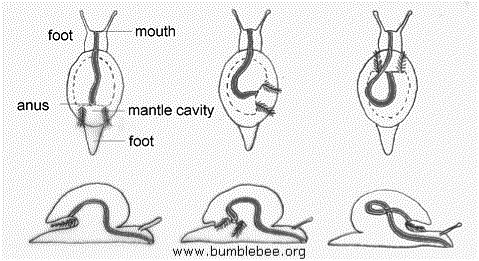
Adaptations
Several adaptations Euconulus alderi have encountered are torsion and coiling, which are characteristics of being in the class Gastropoda. Another adaption is the development of lungs.
Fig. 1 © bumblebee.org
Torsion can be seen in the diagram above. Torsion is a 180 degree twist of the visceral mass. Torsion brings the anus and mantle cavity to the anterior of the snail, above the snail's head. This adaption makes it so the snail only has one opening in the shell, making for better protection against predators. Torsion however posses the problem of fouling since the anus is right above the gills (Hickman 2009).

Fig. 2 © Andrea Finley
Coiling can be seen in the diagram above. In the above diagram the top snail shows no coiling. As the picture progresses downward you can see the shell begin to start growing to the side and towards the posterior end of the snail. Coiling is an adaption that allows the shell to grow with the snail without the shell getting too big. This is possible by the shell growing upward and posterior, meaning the shell does not grow straight above the body, it grows to the side (Hickman 2009).
An adaption that comes from being in the sub-class Pulmonate is
having lungs. The snails no longer have gills, they turn their
mantle cavity into lungs by using the mantle floor muscle to
contract the cavity to fill and release air
(Hickman 2009).
